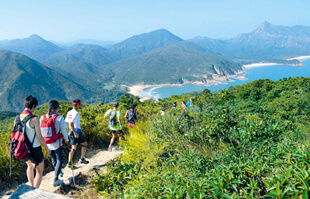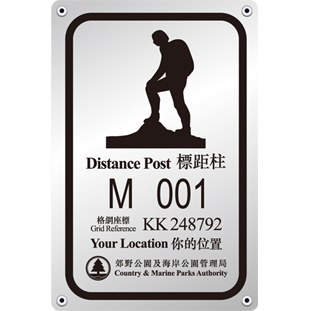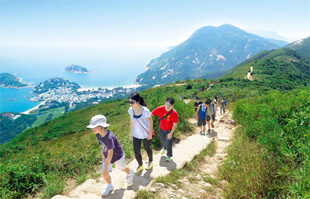Means of Communications in the Countryside
Make Preparations
Before leaving home you should learn about the points to note and the means of communicating in the countryside, so that you can stay in touch and enjoy the natural beauty without any worries. Always find company, and make sure you can remain in contact throughout the trip. You should ensure that your mobile phone, or walkie-talkie if you have one, is fully charged before you leave and that you have a spare battery ready. When hiking, you should try to switch off at least one mobile phone in your group and keep it as a backup.
Find out Mobile Network Coverage and Information in the Countryside
 Mobile network coverage is generally very good in Hong Kong, but due to hilly terrain and remoteness, there are some blind spots in the countryside. The Office of the Communications Authority has conducted a survey of mobile network coverage along popular hiking trails. A series of digital maps are available to indicate mobile network coverage at various locations. Also highlighted are public pay phones and free emergency helplines in case you cannot use your mobile phone.
Mobile network coverage is generally very good in Hong Kong, but due to hilly terrain and remoteness, there are some blind spots in the countryside. The Office of the Communications Authority has conducted a survey of mobile network coverage along popular hiking trails. A series of digital maps are available to indicate mobile network coverage at various locations. Also highlighted are public pay phones and free emergency helplines in case you cannot use your mobile phone.
You can learn more about mobile network coverage from the websites of individual service providers. Just keep in mind that conditions change from time to time, and from place to place, so the information is only meant to be for general reference. Below are links to coverage maps available from selected service providers.
Use Mobile Phones to Make Emergency Calls
It is also important to know how to make an emergency call in the countryside, in case you encounter difficulties. You can:
- Dial 112 or 999: dialling 112 will connect you to the 999 emergency call centre from any local mobile phone network that has coverage in your location
- Use Hong Kong Police Force mobile app "HKSOS": you have to activate the track function before engaging in outdoor activities, so that you can directly connect to 999 emergency response centre in an emergency. The app presents SOS messages in graphic and text. The geolocation of the informant will also be transmitted to facilitate users with hearing and speech impairments.
- Use a roaming service: if you have subscribed to roaming service that is accessible to a mainland network, dial 00852 and then the phone number of a family member, friend or Hong Kong police station. When using a roaming service, please note that you will not be able to contact the 999 emergency call centre by dialling 00852 112 and 00852 999.
You should give as much information as possible about your location when making an emergency call. If you do not have a Global Positioning System device, you can:
- identify the number of the nearest distance post on hiking trails
- describe a prominent nearby landmark and estimate how close it is to your position

A distance post on hiking trail
With this sort of information, the authorities will be able to locate you more quickly than would otherwise be possible.
Use 50222 SMS Hiker Tracking Service and GPS Hiker Tracking Service
With the support of mobile service operators, the Communications Association of Hong Kong (CAHK) has launched the 50222 SMS Hiker Tracking Service (50222 Service). Hikers can use the service by sending short messages to a designated number 50222 to report periodically the unique numbers of Distance Posts they encounter along their hiking trails. This will help keep track of their positions. For example, sending the number M001 means the hiker is at the first Distance Post of the MacLehose Trail. In any event that a hiker is lost, rescue parties can make use of the data stored in the system of 50222 Service to improve the time and success rate of search for the lost hiker.
GPS Hiker Tracking Service has been launched by CAHK due to increasing popularity of smartphones. You have to install the Enjoy Hiking app, developed by the Agriculture, Fisheries and Conservation Department, or the Security Bureau’s Safeguard HK app onto your smartphone. Before your hiking trip, launch either of the apps and activate its Hiker Tracking Service function. The GPS system will then auto feed your tracking locations and record the relevant data at the service centre. The data can be retrieved and used to facilitate rescue if any need arises from an emergency situation.
Use a Roaming Service or IDD Service

When in the countryside, you might not be able to use your mobile phone at all times. Network coverage is sometimes patchy. You can subscribe to a roaming service or bring along a prepaid SIM card with IDD service issued by one of the Mainland mobile network operators. In case of emergency at a place with no coverage of local mobile phone networks but signal from the relevant Mainland mobile network can be received, you may then call for assistance using roaming service (if using Hong Kong mobile SIM card) or IDD service (if using Mainland mobile SIM card). With either of these options, you should be able to call for assistance during an emergency. Using a multi-band mobile phone, which works in multiple frequency bands (including 900MHz, 1800MHz, 2100MHz, 2300 MHz and 2600 MHz bands), will also give you a better chance of successfully contacting the 999 emergency centre.
Use Walkie-Talkies and Global Positioning System Devices
Using walkie-talkies and Global Positioning System (GPS) devices in the countryside can help you keep in touch with your hiking group and can be used to monitor for distress calls from other hikers in more remote areas. A GPS device cannot be used for communications, but it will give you your exact location should you need the help of emergency services.